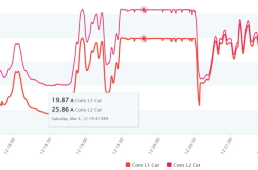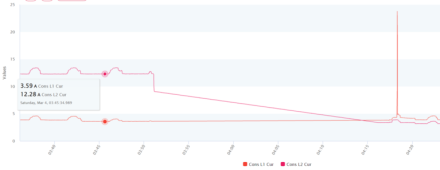svetz
Works in theory! Practice? That's something else
WARNING!
This thread deals with working inside your load center which can be deadly. It is not a place to "learn" about high voltages.
If you think you have a problem and have the slightest doubt as to what you're doing call an electrician to handle it for you.
Note: This is a split-phase topic and won't apply to countries with a single phase (e.g., EU, AU).
It might be anecdotal, but I've heard it's important with split phase to balance loads in a load center as "power" consumed isn't the sum of L1 + L2, it's the maximum. So, if it was always balanced all the time L1 would equal L2 which would minimize consumption thereby reducing costs if on-grid, or reducing demand if off-grid.
So, how do you check and then balance your loads?
Those with solar probably have CTs on L1 and L2 so we can inspect what's going on. For example, I have Enphase and this is mine for the last hour. It looks pretty good with L1 and L2 being close and is primarily the old F22 AC running. One leg being slightly higher than the other is probably my PC as it's a hog and on a single phase.
I know some of the logic, for example, I have a small refrigerator and a small freezer that draw about the same amount of watts, so one is on L1 and the other is on L2 (circuits 3 & 5). Balanced, right?
Well, they don't always run at the same time, so no. In fact, only the vampiric loads ever all run at the same time and they're pretty small. When humans are involved, you never know what's going to run or when.
I also recently discovered that my 4 prong 240V devices are really a combination of 240V and 120V devices, and that my drier is particularly bad at balancing the load, here's a sample of the amps on L1 and L2 while it was the only thing running:
While I might not be able to do anything about the dryer, I have noticed a kW imbalance at 4 A.M on Saturdays. At that time it should just be vampiric loads and things that don't typically get turned off (e.g., the refrigerator). I suspect this particular case, since it doesn't happen every day, is the freezer's defroster:
Those with circuit-level monitoring (e.g., IotaWatt) can probably run some sort of time analysis with the data to optimize the load, possibly @MurphyGuy and @FilterGuy and tell us if they ever took it to the load balancing step.
But electricians have been load-balancing panels for years, so figured a number of you might have some tips.
Last edited:





